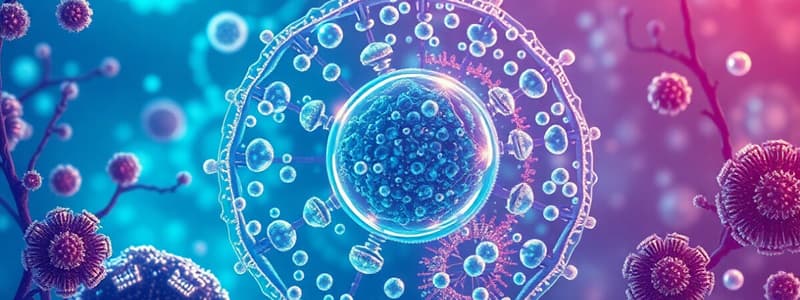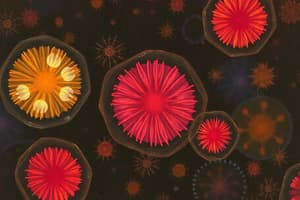Podcast
Questions and Answers
What is the main function of the nucleus in a eukaryotic cell?
What is the main function of the nucleus in a eukaryotic cell?
- Store nutrients
- Synthesize proteins
- Produce ATP
- Regulate gene expression (correct)
Which organelle is primarily responsible for energy production in the cell?
Which organelle is primarily responsible for energy production in the cell?
- Mitochondria (correct)
- Golgi Apparatus
- Ribosomes
- Chloroplasts
What is the primary role of ribosomes within a cell?
What is the primary role of ribosomes within a cell?
- Synthesize proteins (correct)
- Convert sunlight into chemical energy
- Store waste materials
- Modify and package proteins
Which structure helps maintain turgor pressure in plant cells?
Which structure helps maintain turgor pressure in plant cells?
How does the endoplasmic reticulum assist in cellular processes?
How does the endoplasmic reticulum assist in cellular processes?
What is the function of lysosomes within a cell?
What is the function of lysosomes within a cell?
In which type of cell would you find chloroplasts?
In which type of cell would you find chloroplasts?
What is the primary function of red blood cells?
What is the primary function of red blood cells?
Which type of epithelial tissue provides protection against abrasion?
Which type of epithelial tissue provides protection against abrasion?
Where is simple squamous epithelium typically found?
Where is simple squamous epithelium typically found?
What distinguishes pseudostratified epithelium from other types of epithelium?
What distinguishes pseudostratified epithelium from other types of epithelium?
Which type of muscle cells facilitate voluntary movement in the body?
Which type of muscle cells facilitate voluntary movement in the body?
What is the function of glandular cells?
What is the function of glandular cells?
Which of the following epithelial types is specialized for absorption and secretion?
Which of the following epithelial types is specialized for absorption and secretion?
What is the main characteristic of transitional epithelium?
What is the main characteristic of transitional epithelium?
Which type of bone cell is responsible for building new bone?
Which type of bone cell is responsible for building new bone?
What type of epithelium lines the urinary bladder and allows for stretching?
What type of epithelium lines the urinary bladder and allows for stretching?
What key function does glandular epithelium perform?
What key function does glandular epithelium perform?
Which connective tissue type provides structural support and flexibility?
Which connective tissue type provides structural support and flexibility?
Which type of epithelial tissue is specialized for absorption of nutrients?
Which type of epithelial tissue is specialized for absorption of nutrients?
What is the primary role of macrophages in connective tissue?
What is the primary role of macrophages in connective tissue?
What connective tissue type serves to protect and cushion organs?
What connective tissue type serves to protect and cushion organs?
Which of the following functions is associated with epithelial tissue?
Which of the following functions is associated with epithelial tissue?
What type of cells are primarily responsible for producing the extracellular matrix in connective tissue?
What type of cells are primarily responsible for producing the extracellular matrix in connective tissue?
Which type of connective tissue is primarily involved in immune responses?
Which type of connective tissue is primarily involved in immune responses?
Flashcards are hidden until you start studying
Study Notes
Cells: Basic Units of Life
- Cells are the fundamental building blocks of all living organisms.
- They come in diverse shapes and sizes, each specialized for specific functions.
- Eukaryotic cells, like those found in animals and plants, possess various structures called organelles.
Organelles and their Functions
- Cell Membrane: Acts as a barrier, controlling what enters and exits the cell. Also facilitates communication with other cells.
- Cytoplasm: A gel-like substance containing organelles, where many cellular processes occur.
- Nucleus: Contains the cell's DNA, controlling cell activities and holding the genetic blueprint.
- Mitochondria: Powerhouses of the cell, responsible for energy production through cellular respiration.
- Ribosomes: Synthesize proteins based on instructions from messenger RNA.
- Endoplasmic Reticulum (ER): A network of membranes involved in protein synthesis (rough ER) and lipid synthesis and detoxification (smooth ER).
- Golgi Apparatus: Modifies, sorts, and packages proteins and lipids for storage or transport.
- Lysosomes (mainly in animal cells): Break down waste materials and cellular debris.
- Chloroplasts (in plant cells): Contain chlorophyll and carry out photosynthesis, converting sunlight into chemical energy.
- Cell Wall (in plant cells): Provides structural support and protection to the plant cell.
- Vacuoles: Large sacs storing nutrients, waste products, and maintaining turgor pressure in plants.
- Cytoskeleton: A network of protein filaments providing structural support, aiding in cell movement, and transporting materials within the cell.
Types of Cells in the Human Body
- Red Blood Cells (Erythrocytes): Responsible for oxygen transport from the lungs and carbon dioxide transport back to the lungs.
- White Blood Cells (Leukocytes): Part of the immune system, defending against infections and foreign invaders. Different types include lymphocytes, neutrophils, and monocytes.
- Nerve Cells (Neurons): Transmit electrical signals throughout the body, facilitating communication in the nervous system.
- Muscle Cells (Myocytes): Responsible for movement, contracting and relaxing to enable bodily motions. Three types include skeletal, cardiac, and smooth muscle cells.
- Bone Cells: Maintain and build new bone tissue (osteoblasts) and break down old bone (osteoclasts).
- Epithelial Cells: Form protective coverings of body surfaces, line body cavities and hollow organs, and are the main component of glands.
- Fat Cells (Adipocytes): Store energy as fat and provide insulation and cushioning.
- Stem Cells: Undifferentiated cells with the potential to develop into various cell types during development and growth.
- Glandular Cells: Produce and secrete substances like hormones, enzymes, and bodily fluids.
- Cartilage Cells (Chondrocytes): Maintain cartilage, which provides flexible support and reduces friction in joints.
Epithelial Tissue: Covering and Lining
- Epithelial Tissue: Forms a protective barrier, lines cavities, and serves as the main tissue in glands. Classified based on cell layer number and cell shape.
Types of Epithelial Tissue
- Simple Epithelium: A single layer of cells involved in absorption, secretion, and filtration.
- Simple Squamous Epithelium: Flat, scale-like cells found in areas where rapid diffusion or filtration is needed (e.g., lining of blood vessels and lungs).
- Simple Cuboidal Epithelium: Cube-shaped cells found in glands and ducts (e.g., thyroid gland, kidney tubules).
- Simple Columnar Epithelium: Tall, column-like cells lining most of the digestive tract, involved in absorption and secretion.
- Stratified Epithelium: Multiple layers of cells providing protection against abrasion.
- Stratified Squamous Epithelium: Multiple layers of flat cells forming the outer layer of the skin and lining the mouth, esophagus, and vagina.
- Stratified Cuboidal Epithelium: Several layers of cube-shaped cells found in some glandular tissues (e.g., sweat and mammary glands).
- Stratified Columnar Epithelium: Rare, found in specific parts of the pharynx and male urethra.
- Pseudostratified Epithelium: Appears layered due to varying cell heights, but is actually a single layer. Often ciliated and found in the respiratory tract, helping to move mucus.
- Transitional Epithelium: A type of stratified epithelium found in the urinary bladder, capable of stretching and recoiling as the bladder fills and empties.
Locations of Epithelial Tissue
- Skin Surface: Stratified Squamous Epithelium forms the outer layer, providing protection.
- Lining of Blood Vessels and Heart: Simple Squamous Epithelium (Endothelium) lines the interior, facilitating smooth blood flow.
- Respiratory Tract: Pseudostratified Columnar Epithelium (often ciliated) lining the trachea and upper respiratory tract, helps move mucus.
- Digestive Tract: Simple Columnar Epithelium lining the stomach and intestines, aiding in absorption and secretion.
- Kidney Tubules: Simple Cuboidal Epithelium forms the walls, involved in absorption and secretion.
- Glandular Tissue: Cuboidal or Columnar Epithelium found in glands, responsible for secretion.
- Bladder: Transitional Epithelium lines the urinary bladder, accommodating stretching.
- Reproductive Tract: Various types of epithelial tissues line the reproductive organs, facilitating protection and secretion.
Functions of Epithelial Tissue
- Protection: Acts as a barrier against physical, chemical, and biological damage.
- Absorption: Specialized epithelial tissues absorb substances (e.g., nutrients in the intestines).
- Secretion: Produces and releases substances like enzymes, hormones, and mucus.
- Filtration and Excretion: Filter blood to form urine in the kidneys, removing waste products.
- Sensation: Some epithelial tissues contain nerve endings and function as sensory receptors.
- Exchange of Materials: Facilitates gas and nutrient exchange (e.g., alveoli of the lungs and lining of blood vessels).
Connective Tissue: Supporting and Binding
- Connective Tissue: Supports, binds, or separates other tissues and organs.
Types of Connective Tissue
-
Connective Tissue Proper:
- Loose Connective Tissue: Has a loose arrangement of fibers, cushioning and protecting organs (e.g., areolar, adipose, and reticular tissues).
- Dense Connective Tissue: Higher concentration of collagen fibers providing strength and support (e.g., tendons, ligaments, dermis of the skin).
-
Cartilage:
- Hyaline Cartilage: Provides support with some flexibility (found in nose, trachea, ends of long bones).
- Elastic Cartilage: Contains more elastic fibers, found in the ear and epiglottis for flexibility.
- Fibrocartilage: Contains thick collagen fibers for tensile strength (found in intervertebral discs and menisci of the knee).
-
Bone: Provides structural support and protection, forming the skeleton.
-
Blood: A fluid connective tissue transporting nutrients, gases, and waste products throughout the body.
-
Lymph: Fluid involved in the immune response and transport of lymphocytes.
Cells of Connective Tissue
-
Fibroblasts: Produce and maintain the extracellular matrix (e.g., collagen fibers).
-
Adipocytes (Fat Cells): Store energy as fat, provide insulation and cushioning.
-
Macrophages: Engulf and digest cellular debris, pathogens, and foreign substances (part of the immune system).
-
Mast Cells: Release histamine and other chemicals during allergic reactions and infections, involved in inflammation.
-
Plasma Cells: Produce antibodies as part of the immune response (derived from B lymphocytes).
-
Leukocytes (White Blood Cells): Various immune cells (e.g., neutrophils, lymphocytes) that migrate to connective tissue during inflammation or infection.
-
Chondrocytes (in cartilage): Maintain cartilage tissue by producing and maintaining the cartilaginous matrix.
-
Osteocytes (in bone): Mature bone cells that maintain bone tissue.
Functions of Connective Tissue
- Support and Structure: Provides structural support and framework for the body.
- Binding and Connecting: Connects and binds different tissues and organs together.
- Protection: Protects vital organs (e.g., bone encasing the brain, ribcage protecting the heart and lungs).
- Insulation and Energy Storage: Adipose tissue stores fat for energy and provides insulation.
- Transportation: Blood transports nutrients, gases, and waste products.
- Defense and Immunity: Connective tissue contains immune cells that defend against pathogens.
- Repair and Healing: Plays a vital role in wound healing, helping in tissue repair.
Extracellular Matrix (ECM) of Connective Tissue
- Matrix: A complex network providing structural and biochemical support to cells.
- Fibers: Collagen fibers for strength, elastic fibers for stretching, reticular fibers for mesh-like support in soft tissues.
- Ground Substance: An amorphous, gel-like material filling the space between cells and fibers, providing a medium for nutrient and waste exchange. The composition varies among different connective tissues, determining their unique characteristics and functions.
Studying That Suits You
Use AI to generate personalized quizzes and flashcards to suit your learning preferences.




